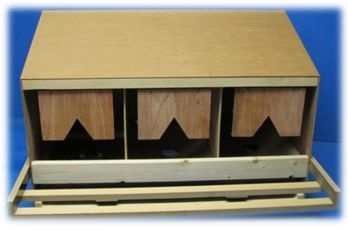
Full transparency of the rack park in electroplating thanks to the system solution with RFID!
Which chicken lays how many eggs?
This task became a challenge. An organic farmer came with the desire to find a way to tell which chicken laid how many eggs.
Before working out a solution, it was first necessary to understand how chickens "work" when laying eggs. Is it random egg-laying - no matter where or when - or does a chicken have a certain methodology? Here was the information from the organic farmer very important.
Chickens usually lay their eggs in nests. These nests are prepared by the organic farmer and placed in the best possible place (dry with straw, etc.) and an important point was thus clarified.
The organic farmer also wanted to ensure that the chickens could roam freely at all times, as free range farming requires.

Transponder on the leg
Finally, the organic farmer requested that the chicken should not be harmed by the technology used.
First is the correct attachement of the transponder to the appropriate chicken, i. H. each chicken gets an RFID transponder (with a unique number). This data is stored in a database. In addition, data on the chicken can be stored, e.g. B. birthday, race, origin etc.
A transponder was used here, which is attached to the legs of the chickens (similar to a pigeon ring). This ensured uniqueness without harming the chicken.
The basic requirement was prepared and now it was time for the nests.

Each nest has an RFID reader
The nests were prepared so that there was a hole in the middle.
The downward sloping nest ensured that the egg always rolled towards the hole. Below the hole was a small spring-loaded flap that gave down as soon as the egg arrived.
At this moment, a switch activates the reader, which reads the chicken in the nest (or the transponder).

A coming and going thanks to RFID
The chickens came and went throughout the day and by the evening the organic farmer knew which chicken had laid how many eggs (or none).
Of course, these readings only make sense if you carry them out over a longer period of time in order to obtain well-founded information.
Another challenge was the desire to keep the chickens safe in the barn at night. It may be hard to believe, but there are still a large number of predators that hunt chickens at night.
With the already existing tag on the legs of the chickens, you can control a flap with RFID, which monitors the entry of the chickens and locks a flap at a desired time.
According to the wishes and requirements of the customer, RadioForce has developed a tailor-made solution that is unique in agriculture to date.
The next challenge will definitely come and we are already looking forward to it!
An extravagant project in an extraordinary environment...

Animal breeding of the future today!
Happy and healthy chickens in their natural environment. So chicken breeding should be operated taking into account a species-appropriate attitude.
RFID technology meets animal husbandry. Technology used sensibly with a win-win situation for EVERYONE!
